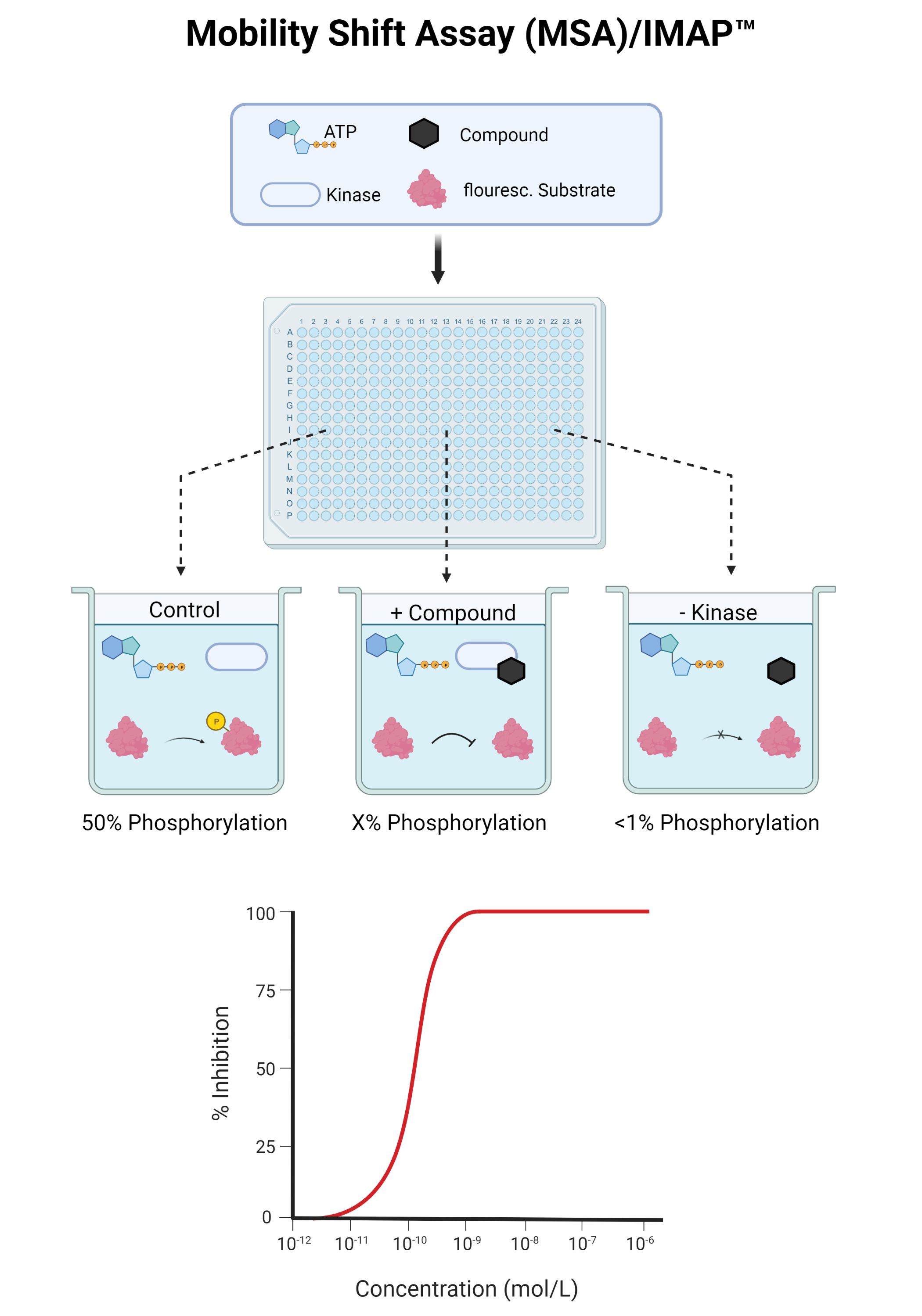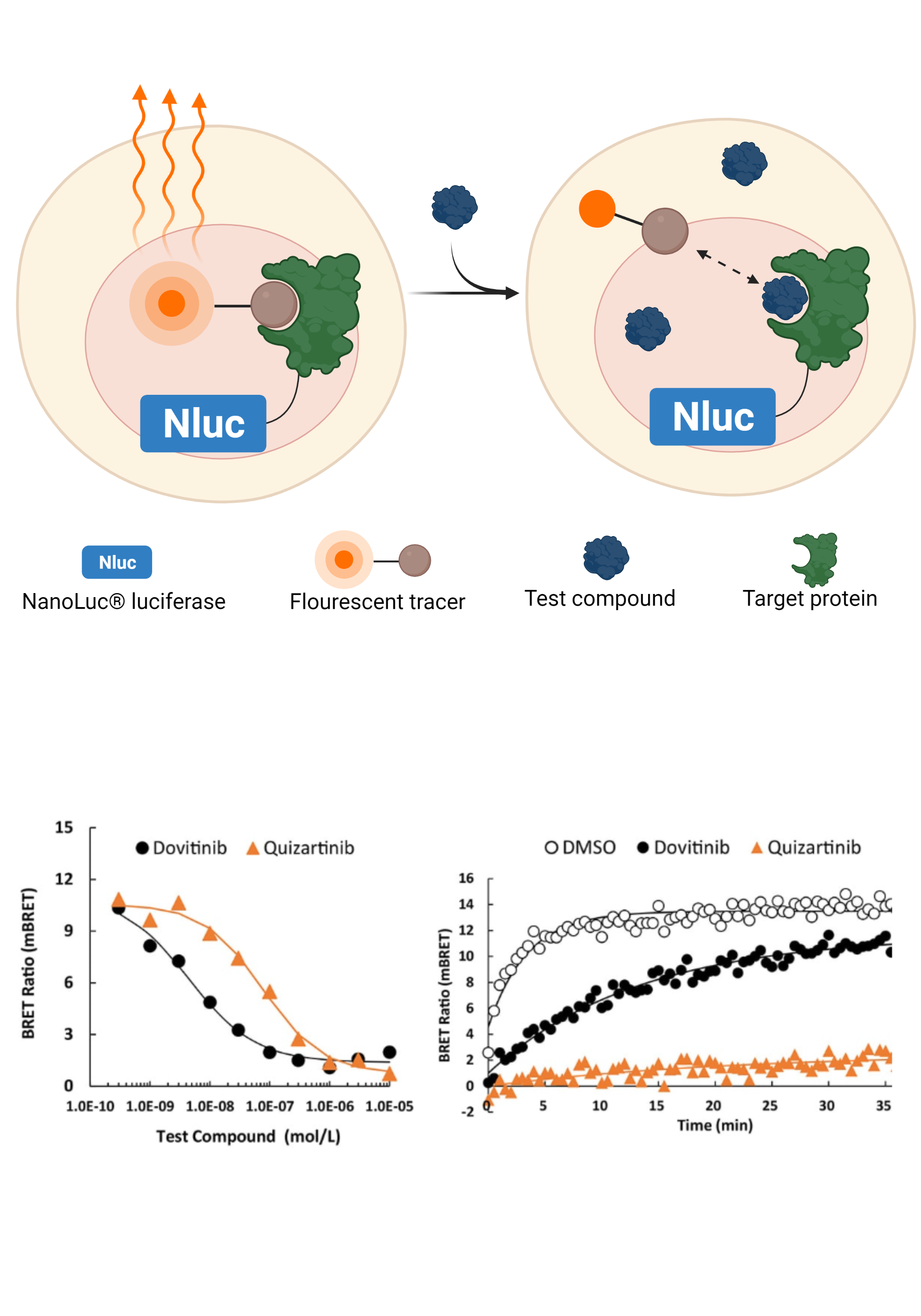Kinase Screening & Profiling
Kinases have become one of the most intensively studied classes of drug targets for many diseases, such as inflammatory diseases and cancer. As a result, kinase inhibitor drugs that block the action of pathologically dysregulated kinases have become an important target for drug discovery. Once a potential kinase inhibitor is identified, kinase screening & profiling are the standard practice to understand how the drug or compound works at the molecular level to produce its therapeutic effects.
Kinase screening & profiling is a method used to identify and measure the activity of different kinases. It involves the use of biochemical or cell-based assays to test the ability of a kinase to catalyze the transfer of phosphate groups to other molecules, as well as to determine its substrate specificity and inhibitor sensitivity. The results are used to understand general potency and selectivity trends of compounds across the human kinome, which assists in target selection, drug prioritization, and potential toxicity implications.
This information can help to guide the development of more effective drugs, identify potential drug interactions and side effects, and deepen our understanding of the underlying biology of the disease being targeted.
The gold standard platforms for kinase screening & profiling have distinct advantages and limitations. The ideal assay platform should be able to detect the activity of a wide range of kinase families, use several substrates, detect activity at low substrate conversion rates, have low data variability, and should not be prone to false positives. With these qualities in mind, we offer activity-based and cell-based kinase profiling services to evaluate the potency and selectivity of your compounds. You can build your own panel or consider our unique pre-selected panels. Simply submit your compound(s) of interest, and we will rapidly perform the assay and deliver results in a short turnaround time.
ACTIVITY-BASED BIOCHEMICAL KINASE SCREENING/PROFILING ASSAY SERVICES
Biochemical kinase screening & profiling platforms are optimized for fast and straightforward kinase profiling reactions. They include kinase and substrate pairs grouped in kinase families or a general panel of kinases of the human kinome. Panels can be customized. Our portfolio covers the Mobility Shift Assay(MSA)/IMAP™ and the ADP-Glo™ Kinase Assay, both ensuring a fast turnaround time and flexible kinase inhibitory profiling & screening.
Mobility Shift Assay(MSA)/IMAP™ Kinase Assay Services
MSA/IMAP™ assays directly monitor phosphorylation by measuring the non-phosphorylated and phosphorylated substrate in the kinase reaction. The technology is based on microfluidics on a microchip, involving the electrophoretic separation and quantification of the fluorescently labeled substrate and the phosphorylated product. The potency and selectivity of your compounds are assessed against the target kinases you select. All kinases utilized in our assays are produced and guaranteed to be of the highest quality, enabling us to deliver high-quality data to you. The ATP concentration in our assays is set around the Km value. For an enhanced understanding of selectivity and allosteric, many assays have also been validated using 1mM ATP. For slow-binding compounds, we offer assays pre-incubating the kinase with your compounds.
ADP-Glo™ Kinase Assay for Lipid Kinase Screening & Profiling
For Lipid kinase screening and profiling, we use the ADP-Glo™ assay platform. The potency and selectivity of your compounds are measured via ADP formed from a kinase reaction. The ADP-Glo™ assay reagents then convert ADP to ATP, which is measured using a luciferase-based reaction. The luminescence (RLU value) produced by the reaction is proportional to the amount of ATP produced and, thus, the kinase activity. This assay is typically performed in a microplate format. The ATP concentration of our lipid kinase assays is set at the approximate Km for each kinase. This assay produces a strong signal at low ATP to ADP conversion, making it well-suited for screening low-activity kinases. Also, the assay can be used at ATP concentrations up to 1mM, which is important for kinases with high Km values for ATP.

CELL-BASED KINASE SCREENING & PROFILING ASSAY SERVICES
Cell-based assays are useful for secondary kinase screening & profiling after initial compound discovery as they test occupancy, selectivity, and affinity within the cellular environment, where engagement naturally occurs. Some small molecule compounds have been shown to be effective in a biochemical assay but fail in subsequent testing in cell-based assays. Even more surprising are compounds that would have been discarded after failure in biochemical assays, but they showed to work in the cell.
Cell-based screening assays provide a more accurate environment like local ion concentrations, compartments with ideal pH, cofactor availability, membrane barriers, and potential cytotoxic effects or off-target effects – all essential to successful drug discovery. Our portfolio covers the NanoBRET™ TE assay, a tyrosine kinase assay, and cell lines for protein-protein interaction detection.
NanoBRET™ TE Intracellular Kinase Assay (HEK293 cells) I Kinase Screening & Profiling
This assay uses bioluminescence resonance energy transfer (BRET) to monitor the activity of kinases in real-time. In the assay, a substrate for the kinase of interest is labeled with two different fluorescent proteins, a NanoLuc® luciferase and a fluorescent protein (NanoBRET™ tracer). When the kinase phosphorylates the substrate, the fluorescent proteins are brought into proximity, which results in energy transfer and a BRET signal. Binding the test compound to the target protein results in a loss of BRET signal between the target protein and the tracer. As a result, the NanoBRET™ TE assay measures the apparent affinity of test compounds by competitive displacement of the NanoBRET™ tracer, reversibly bound to the NanoLuc® luciferase-kinase fusion protein.
This assay allows for real-time monitoring of kinase activity inside living cells, making it a valuable tool for kinase profiling & screening, studying compound affinity and fractional occupancy for kinases under more physiologically relevant information. This assay detects multiple kinase inhibitor types, such as inhibitors with different binding modes (including type I, II, allosteric and covalent). In addition to equilibrium evaluation, it is also possible to obtain the durability of the test compound binding to a kinase (Residence Time), enabling better compound optimization.
Panel Services
Tyrosine Kinase Cell-Based Assays (BA/F3 cells) I Kinase Screening & Profiling
In cooperation with Advanced Cellular Dynamics (ACD, Seattle, WA, USA), we offer a unique cell-based tyrosine kinase assay panel. This service provides tyrosine kinase screening & profiling using transfectants in which activated recombinant kinases are expressed and may help you to discover direct inhibitors to target tyrosine kinases.
The assay relies on constitutively activated kinases providing cytokine-independent growth to IL3-independent Ba/F3 (Pro-B) cell line. The cells are transformed by inducing target genes via viral vectors. The activity of the transformed kinase overrides IL-3 dependency for cellular proliferation and survival. If the kinase inhibitor (compound) specifically blocks the activity of the recombinant kinase, the modified cells undergo programmed cell death (apoptosis), resulting in a lower measurement of residual ATP.
See all available targets
Protein-Protein Interaction (PPI) Detection Assay
Protein-protein interaction detection is the process of identifying and characterizing physical associations between two or more proteins in a biological system. Our split luciferase complementation assay utilizing a unique luciferase derived from Pyrearinus termitilluminans (Emerald Luciferase, E-Luc) is a valuable tool for your study of Protein-Protein Interactions (PPI). This enables the detection of various types of PPIs, including GPCRs, with ease and high sensitivity. In addition to established cell lines on the list, we develop custom stable transfected cell lines suitable to detect specific PPIs of your interest! We also develop transfectant cell lines suitable for custom assay on a fee-for-service basis. The cell assay reagent (Split Glow) will be included with each purchase of a stable cell line.
See all available cell lines

